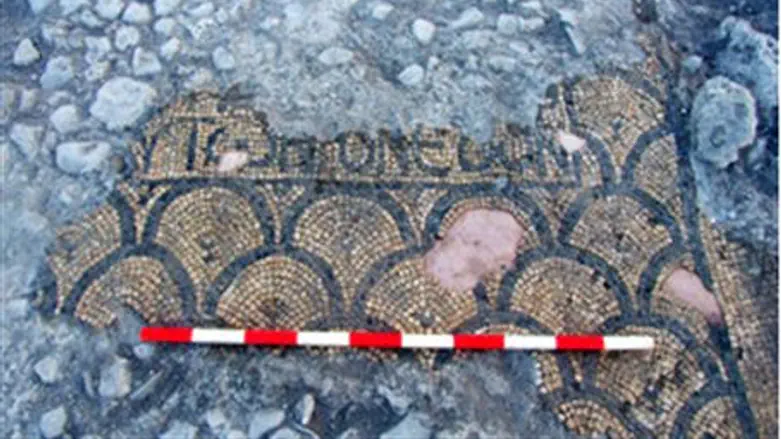
Regards from 1,500 years ago: A third Samaritan synagogue in the Beit She’an area, south of the Kinneret Sea (Sea of Galilee), has been uncovered by archaeologists of the Israel Antiquities Authority. The dig is being conducted with funding from the Ministry of Construction and Housing in preparation for the expansion of a residential neighborhood.
Most of a Greek inscription that states “This is the Temple” was found there, as was a large and colorful mosaic floor. The synagogue, estimated to be some 1,500 years old, was discovered before the holidays, southwest of Bet She’an.
The remains of a farmstead from the Late Byzantine period were also exposed in the dig.
The dig is being directed by Yaakov Harel and Dr. Walid Atrash. “The discovery of another Samaritan synagogue in the agricultural hinterland south of Bet She’an supplements our existing knowledge about the Samaritan population in this period,” the Israel Antiquities Authority explained. “It appears that the structures uncovered there were built at the end of the fifth century, and continued to exist until the eve of the Muslim conquest in 634, when the Samaritans abandoned the complex. The synagogue played an important part in the lives of the farmers who inhabited the surrounding region.”

Bet She’an became an important Samaritan center under the leadership of Baba Rabbah during the Byzantine period (fourth century CE), at which time the Samaritans were granted national sovereignty, the IAI reported.“This was the case until the end of the reign of Emperor Justinian, when the Samaritans revolted against the government. The rebellion was put down and the Samaritans ceased to exist as a nation.”
The building that was exposed consisted of a rectangular hall, 5 by 8 meters, the front of which faces southwest towards Mount Gerizim, which is sacred to Samaritans. Five rectangular recesses were built in the walls of the prayer hall in which wooden benches were probably installed. In the center of the mosaic floor is a Greek inscription; a section of its last line was revealed, reading: T[]OUTON NEWN, meaning, “This is the temple.”
According to historical-geographer and Samaritan-studies expert Dr. Leah Di Segni of Hebrew University, the plan and orientation of the building, and the content of the inscription, are in keeping with a Samaritan synagogue. Two other Samaritan synagogues were discovered in the area in the past.
A farmstead that extends over more than 1,500 square meters was exposed next to the synagogue. The farmhouse was composed of a central courtyard surrounded by storerooms; its southern part included a residence, a guest hall, and industrial installations.